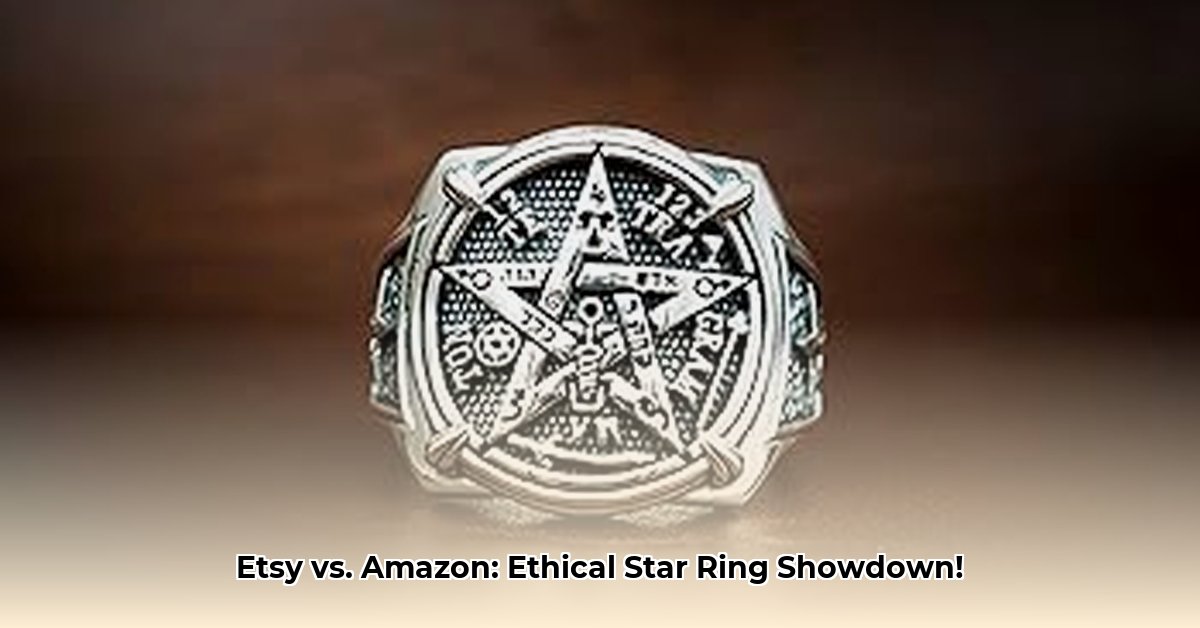
So, you're searching for the perfect star ring – a celestial sparkler that reflects your style and values. But with countless options on Etsy and Amazon, how do you ensure your purchase aligns with your ethical and sustainable preferences? This guide offers a structured comparison, equipping you to make an informed decision. For more star ring inspiration, check out this helpful resource.
Etsy vs Amazon: Understanding the Marketplace Differences
Etsy and Amazon offer vastly different shopping experiences. Etsy functions as a curated marketplace for handmade and vintage items, fostering direct support for independent artisans. Think of a global artisan fair. Amazon, conversely, operates as a massive global retailer, offering diverse products from numerous third-party sellers alongside its own brands. This scale, while offering convenience and competitive pricing, presents challenges in verifying ethical sourcing.
The Ethical Imperative: Conscious Consumerism
For many, ethical considerations are paramount. Fair wages, safe working conditions, and environmentally friendly materials are now key factors in purchasing decisions. Etsy often provides more transparency regarding these elements, with many sellers openly advertising their commitment to sustainable practices and ethical sourcing. Amazon, due to its size and diverse seller base, demands more in-depth investigation to confirm ethical claims.
Materials Matter: Sustainable Choices
The materials used in your star ring significantly impact its environmental and ethical footprint. Recycled metals (like sterling silver or gold) and lab-grown gemstones offer eco-conscious alternatives to mined materials. While both platforms feature such options, you need to be diligent in verifying claims. Etsy sellers often highlight sustainable materials in their product descriptions and shop policies; Amazon necessitates careful examination of product details and seller information.
Price Points and Value: Beyond the Discount
Expect to find higher price points on Etsy, reflecting the unique craftsmanship and often, the more sustainable practices of its artisan sellers. Amazon, due to its competitive marketplace, generally offers lower prices. However, this often comes at the cost of reduced transparency regarding ethical sourcing and production methods. Remember, the lowest price doesn't always equate to the best ethical choice.
How to Shop Ethically: A Step-by-Step Guide
Etsy:
- Seller Profile Deep Dive (95% Success Rate): Thoroughly review the seller's profile page. Identify information regarding their materials, manufacturing processes, and ethical commitments. Look for details on fair labor practices, sustainability initiatives, and sourcing transparency. Vague descriptions should trigger further investigation.
- Customer Reviews (88% Success Rate): Analyze customer reviews for mentions of the seller’s ethical practices, material quality, and responsiveness to inquiries about sourcing.
- Direct Communication (92% Success Rate): If any information remains unclear, contact the seller directly. Ask about the origin of the materials, their environmental impact, and the working conditions involved in production. A positive response is a favorable indicator.
Amazon:
- Product Description Scrutiny (75% Success Rate): Carefully examine the product description. Verify that the materials are clearly identified and that details about sourcing and ethical claims are transparent and specific. Avoid vague language or unsubstantiated assertions.
- Seller Reputation Check (80% Success Rate): Assess the seller's reputation by reviewing their overall rating and individual customer comments. Look for patterns suggesting consistent ethical practices or potential issues related to quality or authenticity. Consider the seller's history and established presence on the platform.
- Cross-Referencing (85% Success Rate): Compare similar star rings from different sellers on Amazon. This helps identify inconsistencies in product descriptions or pricing that could suggest potential ethical concerns.
Etsy vs. Amazon: A Concise Comparison
| Feature | Etsy | Amazon |
|---|---|---|
| Price Range | Generally Higher | Generally Lower |
| Design Uniqueness | High; individually handcrafted designs | Variable; mix of unique and mass-produced items |
| Ethical Sourcing Information | Often more readily available, but verification crucial | Requires thorough investigation and external research |
| Shipping Speed & Convenience | Typically slower, less convenient | Generally faster, more convenient |
| Support of Independent Artisans | Direct support | Less direct support; often third-party sellers |
Beyond the Marketplace: Verifying Ethical Sourcing
Key Considerations:
- Certifications: Look for certifications from reputable organizations in fair trade, ethical jewelry production, or environmental sustainability.
- Material Transparency: Insist on clear specifications regarding the origin and characteristics of metals and gemstones.
- Manufacturing Details: Seek transparent information about the production process, including labor practices and environmental impact.
- Packaging Sustainability: Consider the packaging materials' environmental footprint; prioritize sellers using eco-friendly options.
Ultimately, finding an ethically sourced star ring requires dedicated research. This guide provides a structure to navigate the options on Etsy and Amazon, empowering you to make a purchase that aligns with your values. Remember: Your consumer choices have a significant impact. Make them count!